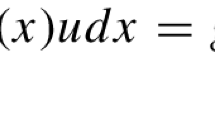Abstract
The approach we used earlier to construct Laurent and regular solutions enables one, in combination with the well-known Newton polygon algorithm, to find formal exponential-logarithmic solutions of linear ordinary differential equations the coefficients of which have the form of truncated power series. (Thus, only incomplete information about the original equation is available.) The series involved in the solution are also represented in truncated form. For these series, the combined approach proposed enables one to obtain the maximum possible number of terms.
Similar content being viewed by others
REFERENCES
S. A. Abramov, A. A. Ryabenko, and D. E. Khmelnov, “Linear ordinary differential equations and truncated series,” Comput. Math. Math. Phys. 59 (10), 1649–1659 (2019).
S. A. Abramov, A. A. Ryabenko, and D. E. Khmelnov, “Regular solutions of linear ordinary differential equations and truncated series,” Comput. Math. Math. Phys. 60 (1), 1–14 (2020).
B. Malgrange, Sur la reduction formelle des equations differentielles a singularites irregulieres (Univ. Sci. Med. Grenoble, Grenoble, 1979).
E. Tournier, Thèse d’État. Université de Grenoble (Grenoble, 1987).
M. Barkatou, “Rational Newton algorithm for computing formal solutions of linear differential equations,” Lect. Notes Comput. Sci. 358, 183–195 (1989).
M. Barkatou and F. Richard-Jung, “Formal solutions of linear differential and difference equations,” Program. Comput. Software 23 (1), 17–30 (1997).
A. D. Bruno, “Asymptotic behavior and expansions of solutions to an ordinary differential equation,” Russ. Math. Surv. 59 (3), 429–480 (2004).
A. D. Bruno, “Expansion of solutions to an ordinary differential equation into transseries,” Dokl. Math. 99 (1), 36–39 (2019).
Maple Online Help. http://www.maplesoft.com/support/help/
G. Frobenius, “Integration der linearen Differentialgleichungen mit veränder Koefficienten,” J. Reine Angew. Math. 76, 214–235 (1873).
L. Heffter, Einleitung in die Theorie der linearen Differentialgleichungen (Teubner, Leipzig, 1894).
E. A. Coddington and N. Levinson, Theory of Ordinary Differential Equations (McGraw-Hill, New York, 1955).
S. A. Abramov, A. A. Ryabenko, and D. E. Khmelnov, “Procedures for searching Laurent and regular solutions of linear differential equations with the coefficients in the form of truncated power series,” Program. Comput. Software 46 (2), 67–75 (2020).
ACKNOWLEDGMENTS
We are grateful to Maplesoft (Waterloo, Canada) for consultations and discussions.
Funding
This work was supported by the Russian Foundation for Basic Research, project no. 19-01-00032.
Author information
Authors and Affiliations
Corresponding authors
Additional information
Translated by E. Chernokozhin
Rights and permissions
About this article
Cite this article
Abramov, S.A., Ryabenko, A.A. & Khmelnov, D.E. Truncated Series and Formal Exponential-Logarithmic Solutions of Linear Ordinary Differential Equations. Comput. Math. and Math. Phys. 60, 1609–1620 (2020). https://doi.org/10.1134/S0965542520100024
Received:
Revised:
Accepted:
Published:
Issue Date:
DOI: https://doi.org/10.1134/S0965542520100024



